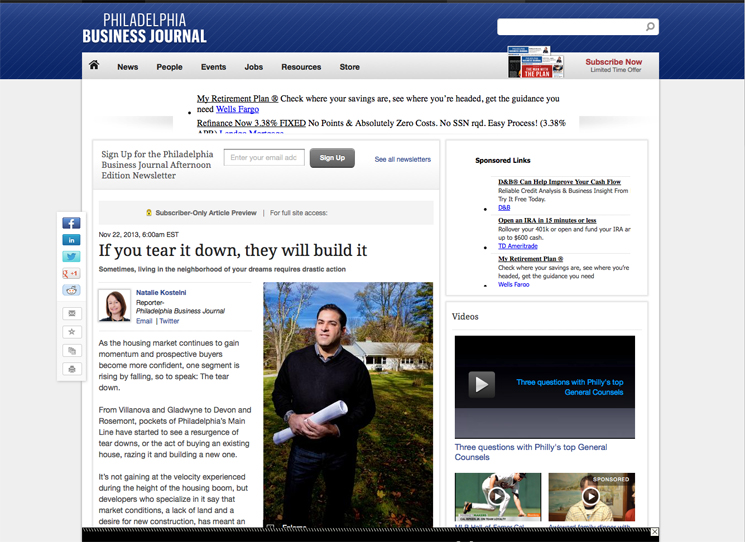
Philadelphia Business Journal
Sometimes, living in the neighborhood of your dreams requires drastic action
As the housing market continues to gain momentum and prospective buyers become more confident, one segment is rising by falling, so to speak: The tear down.
From Villanova and Gladwyne to Devon and Rosemont, pockets of Philadelphia’s Main Line have started to see a resurgence of tear downs, or the act of buying an existing house, razing it and building a new one.
It’s not gaining at the velocity experienced during the height of the housing boom, but developers who specialize in it say that market conditions, a lack of land and a desire for new construction, has meant an uptick in their business.
“I think there’s a new appetite for people willing to spend money on their homes and with respect to the Main Line, there might be three or four places to go into a new community, and other than that you’re left with a tear down,” said Matt Paolino of Paolino Development. “There aren’t 20- to 30-acre pieces of ground to buy and develop so you have in-fill. There’s been a spike in demand.”
Tom Bentley of Bentley Homes has several tear-down projects in various stages and has even started a new “affordable” tear-down line.
Bentley rolled out that model on Devon State Road across from Jenkins Arboretum. There, the company demolished an older house, put a sign up indicating new construction and the phone rang off the hook, Bentley said. While most Bentley Homes sell for well over $1 million, this one was listed for $699,000 and settled for $725,000.
“We’ve seen a lot of interest down under $1 million, but it’s hard to build a home on the Main Line for under $1 million,” Bentley said.
However, a tear down can help offset some new construction costs.
Bentley is always on the hunt for a site that might work for a new house.
“If you’re a builder, every property is a tear down,” Bentley said. “If there’s a million-dollar lot with a beautiful home on it, but I think I can build a $3 million home and sell it, I’ll do it.”
There are two kinds of tear downs, according to Paolino. There’s the tear down for a client who wants a custom house in a particular neighborhood.
The other type is more speculative.
“That’s a numbers game,” he said. “I know what it would cost to tear something down and build a new house.”
His market is between $1 million and $3 million.
There’s no regional data tracking the tear-down market, but experts say the trend points to a recovering residential sector. During the housing peak, so many demolitions were happening along the Main Line that it was dubbed “tear-down mania.” The downturn curtailed activity until recently.
“Lower Merion is a built-out community and these little ranchers on an acre in Gladwyne have a lot of value,” said Art Noelle, assistant director of building and planning for Lower Merion.
The township saw a steady rise in the number of demolitions until activity dropped off in 2007.
This year, Lower Merion has tallied 20 demolitions and 36 newly built houses.
“It’s the highest number of new homes since 2007,” Noelle said.
Tear-downs aren’t without controversy, especially when it comes to razing a structure that has some historical or architectural significance. The National Trust for Historic Preservation has been an advocate for local governments to adopt rules to manage tear downs.
La Ronda, a 17,500-square-foot estate in Bryn Mawr, was an example of how heated the issue can become. The property’s new owner wanted to raze the old mansion. Preservationists and neighbors fought to have the structure stay intact. It was eventually torn down in 2009.
Some neighbors are also sensitive to having a new house built next to them, especially when a McMansion is built next their modest, older rancher.
“In a lot of neighborhoods, people have accepted it, but it’s important to reach out and tell neighbors what’s going on,” said Mark Semerjian of Semerjian Builders, which concentrates on the tear-down market. “People are reluctant to change and even though it should improve the value of their home, people look at it differently and think, I’m the orphaned child here.”
What works best for a tear down is a 50-year old rancher in a mature neighborhood that just wouldn’t make financial sense to renovate.
“A lot of these homes are neglected but people seek out these neighborhoods because they like the feel,” Semerjian said. “People want to build, but they just can’t find the land.”
For example, Semerjian paid $577,000 for a house on two acres off Brooke Road in Wayne. He then tore it down and split it into two one-acre plots and built anew.
It took one of Semerjian’s clients about two years to find the right building lot. It had to be a flat, wooded lot with mature trees in an established neighborhood and preferably in Devon, Berwyn, Wayne or Villanova. The client, who didn’t want to be identified was willing to spend around $700,000 but couldn’t find what he wanted and was forced to bump it up to more like $900,000.
Semerjian finally found a 1950s rancher on a 1.5-acre lot in Devon.
“I had this lot on my radar for quite sometime,” he said.
A deal was struck and the seller was allowed to stay in the house an extra six months to plan her move. Semerjian is constructing an 8,000-square-foot English stone manor house.
The market’s turnaround has convinced Semerjian to move forward on a speculative project on Abrahams Lane in Villanova. He bought the property, which still has a brick house on it, eight years ago. He didn’t build because of market conditions but that has changed.
“That’s going to be a speculative home,” he said, noting it will be in the $5 million range.
BUILDERS GOING WITH THEIR GUT
Not every property makes sense to knock down.
A cousin to the tear-down — the full-blown gut renovation — is also seeing increased activity.
This is a situation where a residential property is purchased but the house has what builders call “good bones” and doesn’t necessarily warrant being razed but rather multiple renovations.
“We’re a lot busier now than we have been since the recession,” said Mark Fox, co-founder of Gardner/Fox Associates Inc., a design-build firm in Bryn Mawr. “The last two quarters were the best in a long time and this is the best year in a long, long time.”
It seems that people are just starting to be more willing to pour money into houses again, Fox said. While his company will do the occasional tear down, much of his work is focused on an existing house with its existing footprint. Sometimes a project will involve a total top-to-bottom renovation and with other properties it entails, for example, taking a single-story house and making it two stories or constructing an addition.
“We’re plugging away,” Fox said. “I just hired someone this week and I haven’t hired someone in a long time.”
– Above Article Featured in the Philadelphia Business Journal


